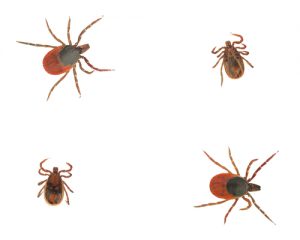Other Tick-Borne Diseases
By Chris Williams on January 25, 2012.
I see deer all the time on my property and am aware about Deer ticks and Lyme disease, but now I’ve heard about a new disease these ticks can transmit. What is it?
It is called Human granulocytic anaplasmosis or HGA and it is yet another concern for persons being exposed to bites by the black-legged (deer) tick Ixodes scapularis. HGA is caused by a bacterium, Anaplasma phagocytophilium and has been found infecting deer ticks through out the New England states and in parts of the North Central US. Connecticut and Rhode Island are two states with some of the highest recording of HGA incidence among the states where it is prevalent. Persons infected with the HGA organism are often difficult to diagnose, because the disease presents with symptoms common to many other illnesses such as fever, chills, headache, muscle aches, etc. Human cases can range from mild to severe (coma, renal failure, and in rare instances, death), but are greatly influenced by the patient’s age and overall health. (ALDF bulletin)
 As with the Lyme disease agent, the main animal reservoir for A. phagocytophilium is the white-footed mouse, (Peromycus leucopus). The life cycle of the deer tick involves three hosts over a two year time period. After black-legged (deer) tick eggs hatch during the spring, larval ticks search for their preferred host (white footed mouse) may become infected with the bacterium during the process of feeding. After taking a blood meal, the larval ticks molt to their second life stage (called a nymph) and overwinter in the soil. The following year, tick nymphs become very active during mid spring to early summer seeking their second host. At this stage of their development they still prefer smaller mammals or birds, but will readily bite people and their pets (A. Eaton 2009). It is probably during this second tick life stage that most accidental transmission of both HGA and Lyme occurs because their peak activity coincides with our favorite season for outdoor activity and they are still very small and easy to miss. After the nymphs have taken a second blood meal, they drop off their host and molt into adults. Adult deer ticks seek out deer or other large mammals and are most active during the fall months (Eaton, 2009) but can also be seen in the spring. My own personal experience confirms this as I routinely find them on my clothing when performing outdoor fall service for our clients, but maybe just once during the spring.
As with the Lyme disease agent, the main animal reservoir for A. phagocytophilium is the white-footed mouse, (Peromycus leucopus). The life cycle of the deer tick involves three hosts over a two year time period. After black-legged (deer) tick eggs hatch during the spring, larval ticks search for their preferred host (white footed mouse) may become infected with the bacterium during the process of feeding. After taking a blood meal, the larval ticks molt to their second life stage (called a nymph) and overwinter in the soil. The following year, tick nymphs become very active during mid spring to early summer seeking their second host. At this stage of their development they still prefer smaller mammals or birds, but will readily bite people and their pets (A. Eaton 2009). It is probably during this second tick life stage that most accidental transmission of both HGA and Lyme occurs because their peak activity coincides with our favorite season for outdoor activity and they are still very small and easy to miss. After the nymphs have taken a second blood meal, they drop off their host and molt into adults. Adult deer ticks seek out deer or other large mammals and are most active during the fall months (Eaton, 2009) but can also be seen in the spring. My own personal experience confirms this as I routinely find them on my clothing when performing outdoor fall service for our clients, but maybe just once during the spring.
With all the tick-borne diseases, the best prevention is avoidance of tick bites. (Surprise!) Dress appropriately for outdoor activities in tick infested areas; check yourself frequently, and at the end of the day also. Wear shoes (not sandals), socks, light-colored clothing for easier detection and use repellants to help keep them off. Specialized insecticide impregnated clothing is also available.